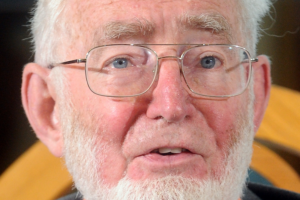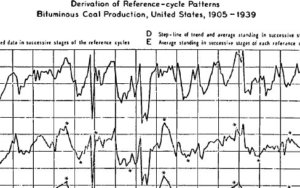Yet, it was only in 1990 that Microeconomics and Macroeconomics were established as independent JEL categories.
The 1948 AEA classification did not use any of the terms, but it nevertheless identified three categories – Economic Systems, National Income, and Business Fluctuations — as “methodological subjects … a general, aggregative and macrocosmic approach to the study of economics (emphasis added).” Micro/macro almost made it to the classification during the next revision, but were eventually dismissed for unclear reasons. The first revision proposal, circulated by AEA secretary James Bell in October 1955, opened with the following category:
Micro and Macroeconomic Theory
(a) Price and Distribution Theory, Welfare economics
(b) Macroeconomics (Theory of Employment; Growth Theory, Consumption Economics; Input-Output)
But Macroeconomics competed with more widely used terms, such as Aggregative Economics, Theory of Price Levels, or the Income and Employment Theory expression eventually chosen, and Price and Allocation Theory was preferred to Microeconomics. Although Bell’s initial choice commanded wide agreement, the main architects of the new classification disliked it for different reasons. Micro and Macro were still widely seen as “forms of analysis” to be used in a variety of fields across the classification, rather than subject matters, and Bernard Haley consequently believed they should not be classified separately. There was indeed no field that could claim for the Macroeconomics heading, since most AEA advisers had resisted the merge of Planning, Business Fluctuations, and Money, Credit and Banking, which ended up as neighboring but distinct categories in the final scheme. Fritz Machlup rather seemed to consider micro and macro as synonym for theoretical work. “Is there any other theory beyond these two branches ?” he wondered. If not, better relabel the opening category “general theory” (in opposition to “applied theory”).
Microeconomics and Macroeconomics entered the AEA classification in 1967, as subheadings of the General Economic Theory category. This structure reflected how the discipline had stabilized during the 1960s. In a AEA report on economic education, national accounting specialist Richard Ruggles, the major architect of the 1967 revision, explained that the purpose of graduate education was “to provide a common core of basic economic theory.” At that time, Nancy Ruggles was gathering essays for a survey of the discipline, eventually published as Economics in 1970. The book opened with the statement that “economic theory represent the core of the discipline,” a core she identified with micro, macro and econometrics. This set of “concepts and mechanisms” the economist would “apply to problems in his own special fields,” such as, presumably, the new Economic Growth, Development, Planning, Fluctuations category created in 1967.
In the next decades, as the classification was being implemented by the editors of the newly created Journal of Economic Literature, the relationships between theory and applied work dramatically changed. Pressures to replace the top Theory category with Microeconomics and Macroeconomicsspecialities spanning both theoretical and empirical work mounted, and when a new revision round was opened late 1987, JEL editor John Pencavel naturally began by writing down the “core.”
It only took him a couple of days to work out the codes for Microeconomics. Its structure, with subgroups ranging from Household Behavior to General Equilibrium and Disequilibrium and Intertemporal Choice, only underwent a few changes afterwards ( titles changes, addition of Distribution and Collective Decision Making subgroups, and reunion of the scattered entries on various types of games in a single Game Theory subgroup, which was moved to the Mathematical and Quantitative Methods category).
By contrast, it took two years to fashion the Macroeconomics category. Pencavel initially intended to end the previous classification’s “uncomfortable division” between Macroeconomic Theory and Economic Growth-Development-Planning-Fluctuations, but he confessed to Drucilla Ekwurzel and Asatoshi Maeshiro, with whom he was working on the new scheme, that he was “particularly unsure of the Macroeconomics organization.” “This insecurity is partly a consequence of my ignorance, no doubt, but also partly the state of macroeconomics,” he explained. His initial plan was to break down Macroeconomics into 4 groups:
Macroeconomics
Measurement of Macroeconomic Variables
Aggregate Demand
Aggregate Supply and Growth
Fluctuations and Policy
Under the influence of James Tobin, John Taylor, Moses Abramovitz and especially Alan Blinder, Pencavel radically rewrote the macro codes. By December 1988, the number of subgroups had risen to 9:
Macroeconomics
General Aggregative Models (with entries for Classical/Marxian/Sraffian, Keynesian and co., monetarists, New Classical and Forecasting models )
Production and Output Growth (including technological change and forecasting)
Consumption and Saving
Capital, Investment, Profit, and Rent
Labor and the Macro Economy (including employment and wage determination)
Price and Business Fluctuations
Money and the Macro Economy
Government and the Macro Economy
Macroeconomic Policy and General Outlook
Macroeconomic Aspects of International Trade and Financial Economics were soon added to the list of subgroups. At that point, the editors realized that the category had grown so much that it could encompass almost every economic work. Again, Pencavel argued that this sprawl was a consequence of the peculiar characteristics of macro:
Most macro. courses touch on material that is taught is other courses (in micro, trade, money, public finance, labor, and so forth) so that, although there is a clearly-defined core consisting of a system of equations describing the essential features of an aggregative economy, there is a wide penumbra of material neighboring on other fields. Hence your concerns about drawing the lines between macro and other classifications reflect very much the nature of the subject.
The status of Monetary Economics, which had hitherto been classified in a separate category, was especially problematic. The JEL editors had initially chosen to classify some topics, such as Measurement and Data on Money and Interest, or Money Demand and Money Supply under Macroeconomics, but the new Financial Economics category was supposed to cover the literature on the nature of money and monetary standards, on the theory if interest rates and their term structure, on portfolio models, and on central banking, among others. In the Spring of 1990, many reviewers reported that the latter category was “lumping … two distinct classes of research – one that might be called Monetary Economics, and the other, more narrowly, Finance.” Pencavel moved all monetary research into Macroeconomics, consolidated consumption, production, employment and investment into a single subgroup, and eventually moved the international component of macroeconomics under International Economics, thereby giving the category its final shape:
E. Macroeconomics and Monetary Economics
E.1.General Aggregative Models
E.2. Consumption, Saving, Production, Employment, and Investment
E.3. Prices, Business Fluctuations, and Cycles
E.4. Money and Interest Rates
E.5. Monetary Policy, Central Banking, and the Supply of Money and Credit
E.6. Macroeconomic Aspects of Public Finance, Macroeconomic Policy, and General Outlook






